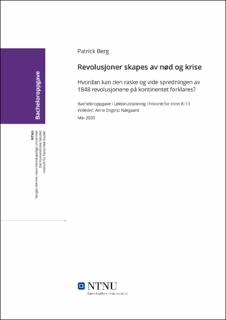| dc.contributor.advisor | Nørgaard, Anne Engelst | |
| dc.contributor.author | Berg, Patrick | |
| dc.date.accessioned | 2021-09-13T16:01:03Z | |
| dc.date.available | 2021-09-13T16:01:03Z | |
| dc.date.issued | 2020 | |
| dc.identifier | no.ntnu:inspera:57494038:23001474 | |
| dc.identifier.uri | https://hdl.handle.net/11250/2775486 | |
| dc.description.abstract | Majoriteten av historieskrivingen om 1848 omhandler i lite eller ingen grad om hvordan revolusjonene utbrøt på tvers av kontinentet. Fokuset har vært, med god grunn, på selve revolusjonene og de politisk-filosofiske idéene som kom i kjølvannet av dem. Men det som gjør disse revolusjonene så unike er hvordan de brøyt ut nesten samtidig i så mange ulike land. Europa var riktignok især grad svært konservativ, som en historisk reaksjon på Napoleonskrigene, men det måtte noe mer til enn politiske idéer for å utløse de voldsomme folkeopptøyene Europa så i 1847/1848. Den beste årsaksforklaringen til de samtidige revolusjonsutbruddene er en agrikulturell krise, hvor Europa mistet først god tilgang til poteten og deretter matkornet, som utløste en økonomisk krise. Denne krisen kolliderte med de harde levekårene for de lavere klassene på tvers av Europa som hadde stadig blitt hardere gjennom første halvdelen av 1800-tallet, og resultatet ble sosiale opprør.
Oppgaven forsøker å plassere 1848 revolusjonene som ble utløst i Vest-Europa i en historisk kontekst for å understreke de sosiale utfordringene de lavere klassene var utsatt for. Det er denne historiske konteksten som undertegnede mener ikke er godt nok representert i historieskrivingen, dog dette er på bedringens vei med moderne historikere som blir presentert i oppgaven. Oppgaven ser derfor på befolkningsvekst, urbanisering, industrialisering, fattigdom og mer og hvordan dette påvirket arbeider- og lavere mellomklasse, altså de massene som senere skulle reise barrikadene i revolusjonene som skulle komme. Deretter ser oppgaven på den agrikulturelle krisen, hvordan den oppstod og hvilke konsekvenser den fikk. Den største konsekvensen var utløsningen av den økonomiske krisen som også blir undersøkt nærmere i oppgaven. Alt dette kulminerer i en analyse av kvantitativ og kvalitativ data som førte, enten direkte eller indirekte, til revolusjonsutbruddene i Vest-Europa i 1848. | |
| dc.description.abstract | The majority of historical research regarding the 1848 revolutions hardly or at all discuss how the revolutions broke out across the continent. The focus has been, quite justifiably, on the revoltions themselves and the political-philosofical ideas that came with them. But what makes the revoltions so unique is how they broke out almost simultaneously in so many countries. Europe was quite conservative, as a historical reaction of the liberal Napoleonic Wars, but there had to be something more than ideas to prompt the violent mass uprisings in Europe 1847/1848. The best explanation of this phenomena is the agricultural crisis, where Europe lost its great access to the potato and then the food cereals, which afterwards lead to the economic crisis in 1847. This crisis collided with the harsh living standards of the lower classes across Europe which had gradually been declining during the first half of the 1800s, and the results became the social uprisings.
This paper attempts to place the 1848 revolutions which broke out in western Europe in a historical context to emphasize the social challenges the lower classes had to put up with. It is this historical challenge that I believe is not well enough represented in the historical research, although this is improving with modern historians which are presented in the paper. This paper will therefore look at the population growth, urbanization, industrialization, poverty and more, and how all this influenced the working and lower middle class – the very masses which would rise up during the 1848 revolutions. Afterwards, the paper will look at the agricultural crisis, how it came to be and which consequences it brought with it. The biggest consequence was the economic crisis which followed, and this crisis is also researched further in this paper. All this culminates in a quantitative and qualitative analysis of data that lead, directly or indirectly, to the revolutions in western Europe 1848. | |
| dc.language | | |
| dc.publisher | NTNU | |
| dc.title | Revolusjoner skapes av nød og krise
Hvordan kan den raske og vide spredningen av 1848 revolusjonene på kontinentet forklares? | |
| dc.type | Bachelor thesis | |
